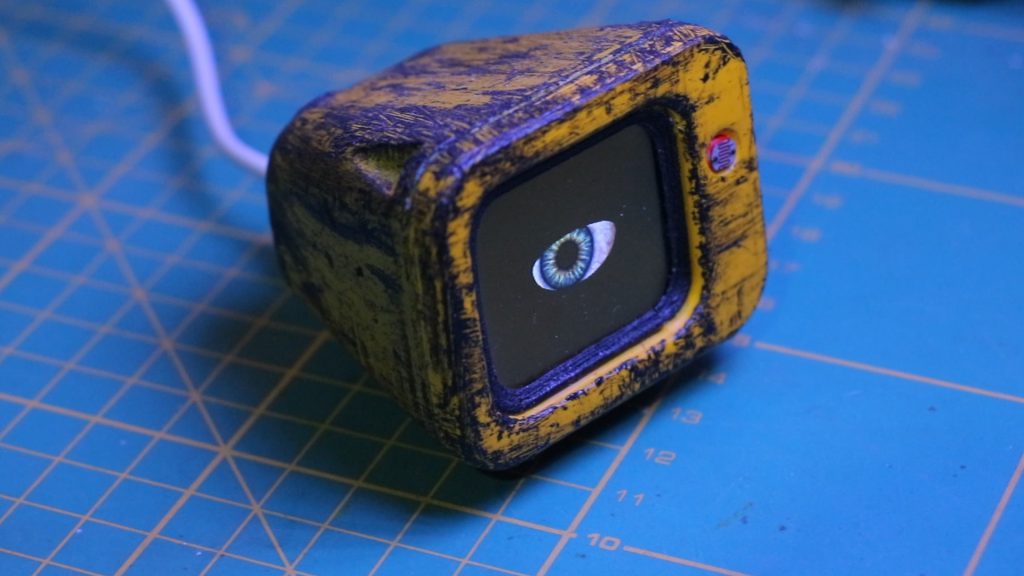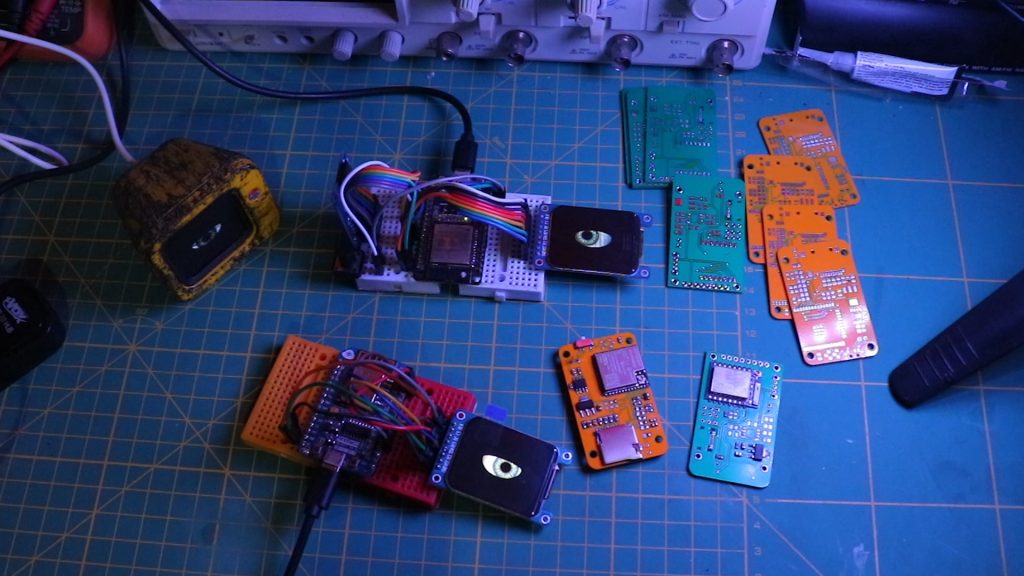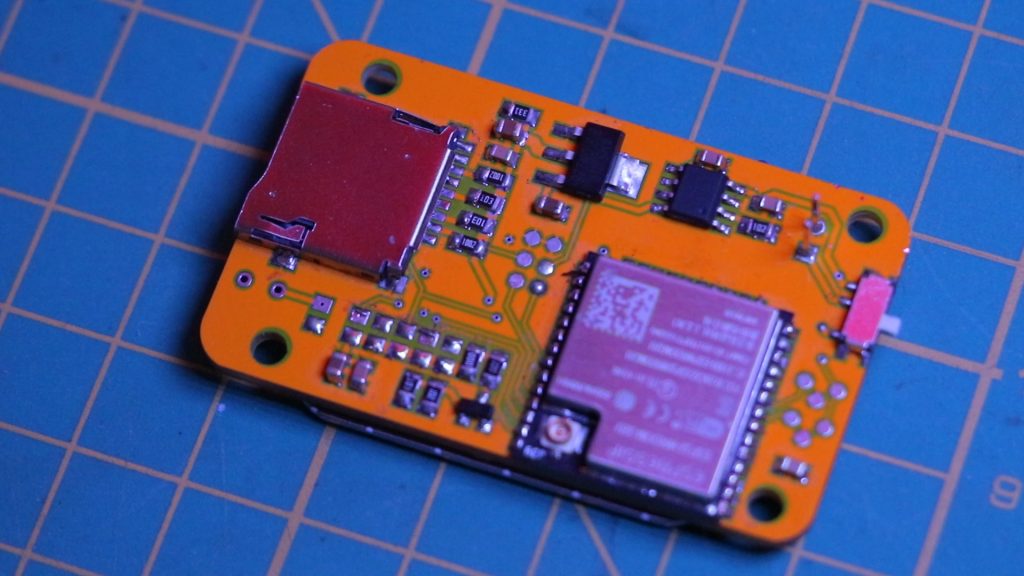🌟 About the Dr. EYE Project
Dr. EYE started as a simple idea, something that I wanted to bring to life just because I thought it would be fun and challenging. I’ve always been fascinated by the intersection of technology and creativity, and I tend to gravitate toward building things that might seem odd or unusual to some—but that’s exactly what excites me.
Honestly, this project wasn’t meant to be perfect from the start. I just wanted to create something that didn’t exist, something that blended both form and function. At first, I wasn’t even sure if it would work! The first prototype, which used the ESP8266 and a TFT LCD, was pretty rough around the edges, but it gave me a chance to experiment and learn.
As I progressed, I realized that Dr. EYE had the potential to be more than just a side project. It could be a fun platform to explore, adding more features as I went along. The whole journey has been about trial and error, learning from mistakes, and making small improvements with each iteration. I’ve upgraded the project to use the ESP32 for better performance, but honestly, it’s still a work in progress.
At the end of the day, this project reflects my love for building things and pushing boundaries, even when I’m not entirely sure where it will lead. And that’s the fun of it.

🎯 Features of Dr. EYE
The current version of Dr. EYE boasts an array of features that make it versatile and functional. Let’s break down the main features:
1. ESP32 and ESP8266 Compatibility
Dr. EYE started with the ESP8266, but as the project progressed, I upgraded it to the more powerful ESP32. The ESP32 offers better performance and the ability to handle more complex tasks, such as smoother video playback on the display. The codebase is flexible and supports both microcontrollers.
2. TFT LCD ST7789 Display
The TFT LCD ST7789 is the heart of the visual aspect of Dr. EYE. Initially, I used the module version, but I later switched to the flat cable version to integrate it directly into the PCB. This display is perfect for rendering crisp images, videos, and animations, making it ideal for a range of applications.
3. Optical Glass Lens for Natural Eye Effect
One of the unique features of Dr. EYE is the addition of an optical glass lens, which adds a natural eye effect to the display. This makes it visually striking, giving the illusion of a real eye, which can be used in various creative and functional ways.
4. MicroSD Card Slot
Although not fully utilized yet, the microSD card slot provides additional storage options for the device. This feature opens up future possibilities such as storing and playing videos, saving images, or even recording CCTV footage if Dr. EYE is used in a security application.
5. TP4056 Battery Charger
Portability is key for any modern device, and Dr. EYE is no exception. With the TP4056 battery charger, you can power the device using a rechargeable battery, making it perfect for on-the-go applications. This adds another layer of convenience, allowing the device to be used in remote or mobile setups.
6. Over-the-Air (OTA) Updates
Thanks to ESP32 OTA (Over-the-Air) functionality, you can update the device’s firmware wirelessly without needing to physically connect it to your computer. This feature is a game-changer for development and maintenance, especially when working with a compact PCB where physical connections can be challenging.
7. Compact PCB Design
The project makes use of a compact PCB design, integrating all components, including the ESP32, TFT LCD, power management, and SD card slot. This compact design ensures the device is portable and easy to manage, despite packing in several features.

🎨 The Artistic Side of Dr. EYE
While Dr. EYE is a functional, tech-driven project, there’s an equally important artistic side to its creation. At its core, this project merges the realms of technology and art, where the visual display isn’t just a screen showing data—it becomes a piece of art that can evoke emotion and creativity.
1. The “Eye” as a Symbol
The eye has long been a powerful symbol in various cultures and art forms. It represents vision, knowledge, perception, and sometimes even surveillance. By incorporating an optical glass lens and a natural eye effect, Dr. EYE taps into this symbolic world, turning the display into something that feels alive. The device becomes more than just an electronic gadget—it starts to resemble a living entity that watches, perceives, and interacts with its surroundings.
2. Blurring the Line Between Art and Technology
In modern times, the lines between art and technology have increasingly blurred. Dr. EYE is a great example of this. It’s not just about coding and circuitry—it’s about creating an immersive, aesthetic experience. The choice of using a TFT LCD to represent an eye creates an artistic visual that can be integrated into installations, interactive art, and even wearable projects.
With the ability to display animations, visuals, and even videos, Dr. EYE can be a canvas for digital art. Imagine loading dynamic eye animations, colorful patterns, or abstract designs onto the screen. The possibilities are endless for artists who want to explore new mediums in their work.
3. Customization and Creative Expression
One of the key artistic aspects of Dr. EYE is its potential for customization. The device’s visual output can be tailored to different needs—whether it’s showing abstract digital art, displaying live camera feeds, or even reacting to environmental data. The integration of a microSD card also opens up endless possibilities for storing and displaying art, giving the creator full control over what appears on the screen.
4. Future Art Installations and Concepts
Looking ahead, Dr. EYE could be integrated into larger-scale art installations. Imagine a room filled with multiple Dr. EYE devices, each reacting to the movement of people or changes in the environment. The eye-like displays could follow visitors as they walk by or display different emotions based on the data they receive. These kinds of interactive art projects can engage audiences in unique ways and make them feel a part of the installation.

👀 Use Cases
Relax and witness Dr. EYE observing you.
![]()
Code & PCB
The project is not completed at the moment. I need to make a few changes before sharing the files and records. Follow me on GitHub for updates. The resources will be available soon.
My GitHub: github.com/cifertech

 Special Thanks to Our Sponsor: JLCPCB
Special Thanks to Our Sponsor: JLCPCB
No project is complete without the right tools and materials. That’s where our sponsor, JLCPCB, stepped in to provide essential support for this project. JLCPCBis a leading provider of high-quality printed circuit boards (PCBs) and PCB assembly services.
Simply head over to jlcpcb.com, upload your PCB design files, select your preferences, and Your custom PCBs are on their way to you in no time.

Check out JLCPCB Engineers Day deals to Get $125 off coupons, Bulk order discount, and the chance to win a $150 Amazon gift card. Check out the JLCPCB website.
🌟 Conclusion
The Dr. EYE project has been a fun and rewarding journey, from the initial prototype on the ESP8266 to the current, more advanced version using the ESP32. With features like the TFT LCD ST7789, microSD card slot, and OTA updates, Dr. EYE is a versatile device with endless possibilities. Whether you want to use it for security, art, or simply as a fun DIY project, the potential is only limited by your creativity.
In future updates, I plan to fully integrate the SD card functionality, improve the performance of the display, and add even more features. Stay tuned, and I hope this blog inspires you to build your own version of Dr. EYE or something entirely new!
And remember, “The power to create what you imagine lies within you.” So go ahead, start building, and see where your creativity takes you!


